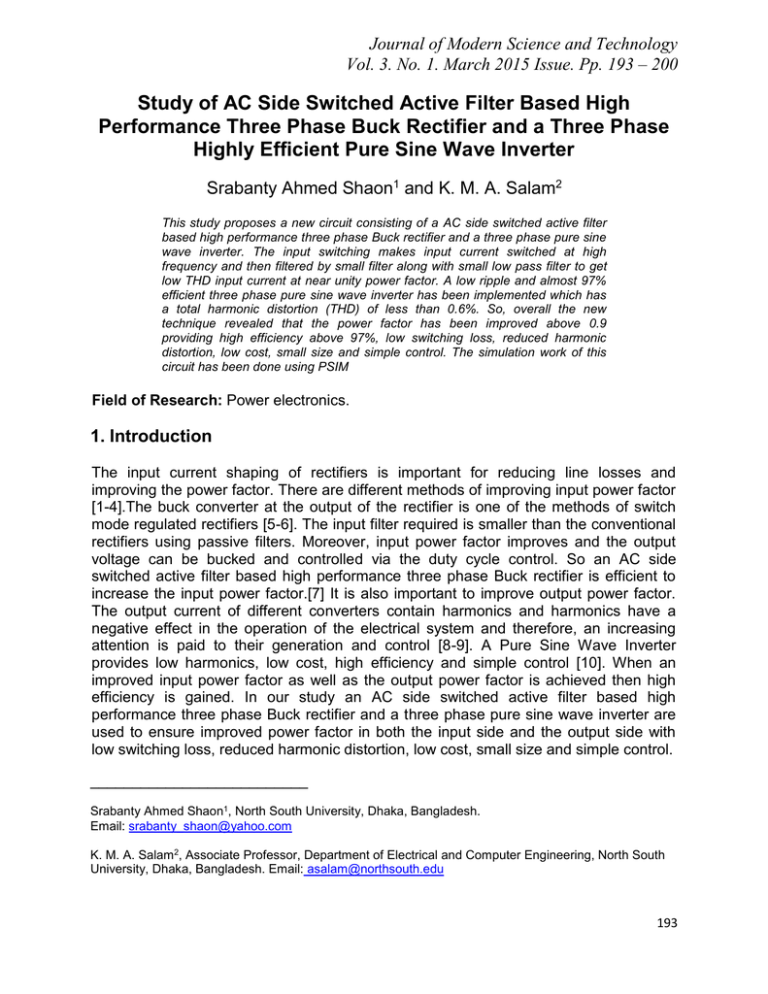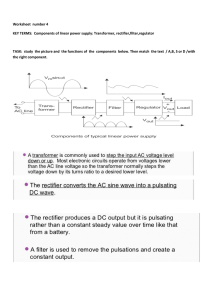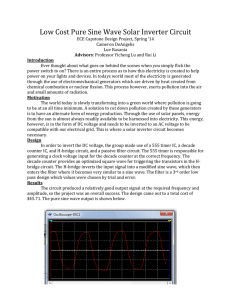
Journal of Modern Science and Technology
Vol. 3. No. 1. March 2015 Issue. Pp. 193 – 200
Study of AC Side Switched Active Filter Based High
Performance Three Phase Buck Rectifier and a Three Phase
Highly Efficient Pure Sine Wave Inverter
Srabanty Ahmed Shaon1 and K. M. A. Salam2
This study proposes a new circuit consisting of a AC side switched active filter
based high performance three phase Buck rectifier and a three phase pure sine
wave inverter. The input switching makes input current switched at high
frequency and then filtered by small filter along with small low pass filter to get
low THD input current at near unity power factor. A low ripple and almost 97%
efficient three phase pure sine wave inverter has been implemented which has
a total harmonic distortion (THD) of less than 0.6%. So, overall the new
technique revealed that the power factor has been improved above 0.9
providing high efficiency above 97%, low switching loss, reduced harmonic
distortion, low cost, small size and simple control. The simulation work of this
circuit has been done using PSIM
Field of Research: Power electronics.
1. Introduction
The input current shaping of rectifiers is important for reducing line losses and
improving the power factor. There are different methods of improving input power factor
[1-4].The buck converter at the output of the rectifier is one of the methods of switch
mode regulated rectifiers [5-6]. The input filter required is smaller than the conventional
rectifiers using passive filters. Moreover, input power factor improves and the output
voltage can be bucked and controlled via the duty cycle control. So an AC side
switched active filter based high performance three phase Buck rectifier is efficient to
increase the input power factor.[7] It is also important to improve output power factor.
The output current of different converters contain harmonics and harmonics have a
negative effect in the operation of the electrical system and therefore, an increasing
attention is paid to their generation and control [8-9]. A Pure Sine Wave Inverter
provides low harmonics, low cost, high efficiency and simple control [10]. When an
improved input power factor as well as the output power factor is achieved then high
efficiency is gained. In our study an AC side switched active filter based high
performance three phase Buck rectifier and a three phase pure sine wave inverter are
used to ensure improved power factor in both the input side and the output side with
low switching loss, reduced harmonic distortion, low cost, small size and simple control.
__________________________
Srabanty Ahmed Shaon1, North South University, Dhaka, Bangladesh.
Email: srabanty_shaon@yahoo.com
K. M. A. Salam2, Associate Professor, Department of Electrical and Computer Engineering, North South
University, Dhaka, Bangladesh. Email: asalam@northsouth.edu
193
Shaon & Salam
2. An AC Side Switched Active Filter based High Performance Three
Phase Buck Rectifier
Figure 1: Three Phase Buck
In the circuit shown in Fig.1 Ls is used as buck inductor and L1, L2 and L3 are used as
input filter inductors.C4, C5 and C7 are the input filter capacitors. Resistance R1, R2
and R3 and capacitor C1, C2 and C3 are used to design the additional low pass filter
that is required due to the comparative high THD value of buck operation. Capacitor Cs
is used to reduce ripple of the output dc voltage.The operation principle of a three phase
rectifier switched at the input by a bi-directional switch is similar to the single phase
circuit [7].
Figure 2: Single Phase Buck Rectifier
Fig.2 shows a single phase buck rectifier with resistive load switched by a bi-directional
switch at the input. [7] The inductor at the output side of the circuit acts as the buck
inductor. The bridge rectifier connected to load acts as buck diode in the overall circuit.
In the input side the resistor, inductor and capacitor work as input filter to shape the
current. In the positive supply cycle, when the switch is turned ON, inductor gets
charged via two diodes of the rectifier enclosing the unidirectional switch. When the
switch turns off during positive supply cycle, supply voltage and the inductor voltage is
applied together across the load via two diodes of the rectifier connected to the load.
When the switch is off, source current becomes zero (which is the main reason for high
THD in buck operation); current pass through the filter to maintain its sinusoidal form.
194
Shaon & Salam
3. Pure Sine Wave Inverter
In the Inverter design Sinusoidal Pulse Width Modulation (SPWM) is used to generate
sine wave output from DC input. SPWM technique is implemented by constant
amplitude pulse with varying duty cycle for each period. To generate SPWM signals a
high frequency triangular wave is used as carrier signal (Vc), which is compared with
sinusoidal wave that is called reference signal (Vr) [11-12]. The most important
parameter of designing the switching strategy is amplitude modulation (MA) that will
influence the performance of the inverter. MA is defined as the ratio between sine
waveform also termed as reference signal and the triangular waveform also termed as
carrier signal. The amplitude modulation is determined by the following equation:
MA=
(1)
MA plays a crucial role to determine the output voltage of the inverter. However,
theoretically if MA value increases, the AC output voltage of the inverter will be
increased. Based on the equation (1), MA value should be less than 1, in order to
achieve a high voltage gain with fewer harmonics. So filter designing is getting easier if
the MA value choose between 0.8 and 0.9. The harmonics at MA greater than 1 will
also increase. This condition is known as over modulation [10].
4. System Model
Figure 3: Schematic Diagram of Proposed Combined Circuit of Three Phase
Buck Rectifier and a Pure Sine Wave Inverter
Fig.3 represents the model of a R-L load using three phase Buck rectifier and a three
phase highly efficient pure sine wave inverter. The Buck Rectifier in which the input ac
voltage is rectified dc voltage. The MOSFET is triggered using a triangular pulse wave.
The three phase two pure sine wave inverter, where the MOSFETs are triggered using
a triangular pulse of 12V. We also use a L-C filter to minimize the distortion. The last
195
Shaon & Salam
part of this circuit is the R-L load. Input power factor improves and the output voltage
can be bucked and controlled via the duty cycle control. Duty cycle is
D=
×100%
(2)
where D is the duty cycle, ton is the time the signal is active, and T is the total period of
the signal.
5. Simulation Result
Fig.4 shows the input voltage. Fig.5 exposes the input current before filtering. Fig.6
shows the filtered input current which contains low THD than the unfiltered
one.Fig.7shows output current of the inverter. It contains ripple. To minimize this
distortion we use a L-C filter. Then we get a almost ripple free current curve of the
inverter in Fig.8. Same scenery has been achieved in the case of voltage. Fig.9 reveals
a distorted voltage of the inverter before using filter while almost pure sinusoidal voltage
curve is achieved in Fig.10 after using the L-C filter. L-C filter is available in market at
low cost. So, it is cost effective. L-C filter can be handled easily. So, it also provides
simple control of the circuit.
Figure 4: Input Voltage
Figure 5: Input Current before Filtering
196
Shaon & Salam
Figure 6: Input Current after Filtering
Figure 7: Output Voltage of the Pure Sine Wave Inverter before Using Filter
Figure 8: Output Voltage of Highly Efficient Pure Sine Wave Inverter after Filtering
197
Shaon & Salam
Figure 9: Output Current of Pure Sine Wave Inverter before Using Filter
Figure 10: Output Current of Highly Efficient Pure Sine Wave Inverter after
Filtering
6. Performance Analysis
In the rectifier circuit if we increase duty cycle input power facto increases but THD also
increases and in turn efficiency decreases. Again the efficiency of the rectifier circuit increases if
we use smaller filter inductor and capacitor. In this paper we have done the same. Small sized
capacitor and inductor are used to design the filter. The output current and voltage of the pure
sine wave inverter have been pure sinusoidal after using L-C filter. Before that there was ripple.
An improved power factor of 0.91 has been achieved at the output side also. Fig. 11 shows the
power factor vs duty cycle when applied the MOSFET’s triggering pulses of the highly efficient
pure sine wave inverter. It is further revealed that the power factor is improved up to above 0.9
after using the MOSFET’s triggering pulses of the highly efficient pure sine wave inverter.
198
Shaon & Salam
0.95
0.9
0.85
0.8
0.75
0.7
0.25
0.3
0.35
0.4
0.45
0.5
0.55
0.6
0.65
0.7
0.75
Figure 11: Power Factor Vs Duty Cycle for Pure Sine Wave Inverter’s Gate
Pulse When The Rectifier’s Duty Cycle is Fixed At 0.25.
So, it is seen that this new circuit provides power factor improvement with low harmonic
distortion.
7. Conclusion
The Three Phase Buck rectifier chops the input current at the AC side in contrast to the
conventional schemes which chops the rectified output. The main advantage of this
circuit is smaller input filter. It provides low input THD and high input power factor. Again
the simulation result shows that the three phase pure sine wave inverter produces a
high quality ripple free sinusoidal AC curve with a voltage THD below 0.1% which is
very much lower than IEEE 519 standard. However, the power factor improved above
0.9 when we use a combined three phase buck rectifier and a highly efficient pure sine
wave inverter. The significance of this new circuit is to provide higher power factor, high
efficiency, low switching loss, reduced harmonic distortion, low cost, small size and
simple control that may be the application of modern power electronic systems.
8. Limitations and Further Research:
This circuit has not been implemented in hardware. So, Experimental Implementation
may be the further research.
199
Shaon & Salam
References
Arrillaga, J., and Watson, N. (2003), Power System Harmonics, 2nd ed, John Wiley &
Sons. Inc, pp. 219-259.
Chandra, A. and Agarwal, T. (2014), ‘Capacitor Bank Designing for Power Factor
Improvement’, International Journal of Emerging Technology and Advanced
Engineering, 2250-2459, vol. 4, no. 8, pp.235-239.
Chowdhury, K. S. A., Shehab, S. M., Abdul, A. M., and Razzak, A. M. (2013), ‘Design
and implementation of a highly efficient pure sine-wave inverter for photovoltaic
applications’, Informatics, Electronics & Vision (ICIEV), International
Conference,17-18 May, Dhaka, IEEE, pp.1-6.
Hart, D. W. (1997), Introduction to power electronics, Prentice Hall, India. pp.13-37.
Hossain, A., Galib, H. T., and Choudhury, M. A. (2013), ‘AC Side Switched Active Filter
Based High Performance Three Phase Buck Rectification’ Informatics,
Electronics & Vision (ICIEV), International Conference, Dhaka, 17-18 May, pp.16.
Kolar, J. W., and Friedli, T. (2011), ‘The essence of three-phase PFC rectifier systems’,
IEEE 33rd International Telecommunications Energy Conference (INTELEC),
Amsterdam, Oct 9-13, IEEE, pp.1 – 27.
Mohan, N., Undeland, T. M., and Robbins, W.(2006), Power Electronics, 3rd ed., MA:
John Wiley & Sons, Inc., Denvers, pp. 211-214.
Nadi, R. N. and Srabanty, S. A. (2013), ‘Power Factor Improvement using Vienna
Rectifier and Buck Boost Converter’, International Journal of Scientific &
Engineering Research,vol.4, no.7, pp. 4.
Paice, D. (1996), Power Electronic Converter Harmonics -Multipulse
Methods for
Clean Power, 2nd ed, IEEE Press, pp.1-13.
Rashid, M. H. (2008), Power electronics circuits, devices, and applications, Pearson
Prentice Hall, India, pp.213.
Rashid, M. H. (2007), Power Electronics, Circuits, Devices and Applications,3rd ed,
Prentice-Hall, New Delhi, pp. 253-256.
Sanjit, P., and Aurasopon, A. (2015), ‘Asymmetrical PWM for Harmonics Reduction and
Power Factor Improvement in PWM AC Choppers Using Bee Colony
Optimization’, Journal of Power Electronics, vol.15, no.1, pp.227-234.
200







